The eye follows the paths that have been laid down for it in the work.—Paul Klee, Pädagogisches Schizzenbüchen
1The studioli of the ducal palaces at Urbino and Gubbio offer elegant demonstrations of architecture's capacity, as a discipline and medium, to transact between the mental and physical realms of human experience. Constructed between 1474 and 1483 for the military captain Federico da Montefeltro, of Urbino, the studioli may be described as treasuries of emblems, for they contain not things but images of things, rendered with remarkable perspectival exactitude. Over the past five centuries, these chambers have themselves become emblems for the intellectual milieu at the court of Urbino, crystallizing a unique brand of humanism1 that spanned the mathematical and verbal as well as liberal and mechanical arts.
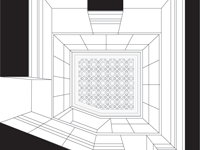 Fig. 1.1. Worm's eye view of the Urbino studiolo walls and ceiling. Fig. 1.1. Worm's eye view of the Urbino studiolo walls and ceiling. |
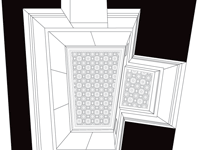 Fig. 1.2. Worm's eye view of the Gubbio studiolo. Fig. 1.2. Worm's eye view of the Gubbio studiolo. |
2Owing to their comprehensive iconographic programs—which encompass the seven liberal arts,2 the muses and virtues,3 the heraldic imagery of the Montefeltro, and Duke Federico's personal accomplishments—the studioli might be interpreted as encyclopedic containers of universal knowledge. Yet careful review of these emblems and their perspectival arrangement reveals that the studioli might have served more as a rhetorical medium for stimulating thought than as representations of a "complete" body of knowledge. Considered in light of recent scholarship in earlier pedagogical traditions, these chambers may be appreciated as associative engines whose marvelous visual character assists an occupant to forge new constellations of meaning from a set of carefully selected and arranged figures. As such, the studioli extend an ancient legacy of open-ended architectonic models, conceived to activate the imagination and exercise the memory as an inventive agency for knowing.
3
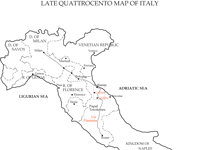 Fig. 1.3. Map of Italy circa 1480.Architecturally, the Urbino and Gubbio studioli are capstones to the ambitious building program that Federico sponsored from the 1460s and that continued for almost a decade after his death. For the most intense periods of construction, the duke enlisted two architects, first Luciano Laurana and later Francesco di Giorgio Martini, to redesign the numerous palaces and fortifications of his expanding dukedom. Completed during di Giorgio's tenure—Urbino in 1476 and Gubbio in 1483—the studioli reflect an intense collaboration among the many scholars and artists that Federico and his brother, Ottaviano degli Ubaldini, gathered to their court.4 Although various artists have alternately been championed as their progenitor, any definitive attribution for these chambers is highly contestable, if not somewhat beside the point. The studioli offer testament to the syncretic and convivial atmosphere cultivated at Urbino, as registered and further idealized in the works of Piero della Francesca, Fra Luca Pacioli, and Baldassare Castiglione.
Fig. 1.3. Map of Italy circa 1480.Architecturally, the Urbino and Gubbio studioli are capstones to the ambitious building program that Federico sponsored from the 1460s and that continued for almost a decade after his death. For the most intense periods of construction, the duke enlisted two architects, first Luciano Laurana and later Francesco di Giorgio Martini, to redesign the numerous palaces and fortifications of his expanding dukedom. Completed during di Giorgio's tenure—Urbino in 1476 and Gubbio in 1483—the studioli reflect an intense collaboration among the many scholars and artists that Federico and his brother, Ottaviano degli Ubaldini, gathered to their court.4 Although various artists have alternately been championed as their progenitor, any definitive attribution for these chambers is highly contestable, if not somewhat beside the point. The studioli offer testament to the syncretic and convivial atmosphere cultivated at Urbino, as registered and further idealized in the works of Piero della Francesca, Fra Luca Pacioli, and Baldassare Castiglione.
4Scholars have recently positioned the studioli and contemporary rooms of their kind at the origins of the modern museum, as spaces of inquiry and leisure newly emerged between the private and public realms.5 It is tempting to compare the visual character of the studioli, regarded in their time as marvelous works,6 with the "cabinets of curiosities" of the 16th and 17th centuries, filled as they were with a new world of things and ontological uncertainties prompted by Christopher Columbus's westward voyage in 1492. Though not entirely inaccurate, since the effectiveness of the studioli was predicated on their capacity to induce wonder, direct comparisons should be tempered. Columbus had not yet set sail. Although the perspectival composition of the studioli reflects a new organizational status accorded the eye, foreshadowing the empirical interdependence of witnessing and believing,7 it was not yet the world of Giulio Camillo, famed for his memory theater, who exclaims, in The Art of Memory (1560), "Let's turn scholars into spectators."8
5In the studioli, practices of visualizing knowledge were influenced, but not yet commanded, by the corporeal eye. Knowing was still conceived as the cultivation of wisdom in the mind's eye, nourished by a well-trained memory. Icons and emblems were believed to convey one's thoughts directly between the inner seat of emotional witness and the outward aspirations of community, with the architecture of memory facilitating intercourse between thought and matter.
6Nonetheless, the studioli do represent a significant turning point in the role of sight in verifying experience. In particular, the chambers manifest a transformation in practices of envisioning knowledge, from an inward habit of mnemonic composition toward a more extroverted mediation of the world as a theater for the corporeal eye and its prosthetic instruments. By their visual arrangement, the studioli demonstrate the emergence of a quantitative methodology for representing reality, a scientia mechanica centered on the belief that humans might participate directly in the workings of the universe. "Heavenly things are present in the hidden life of the world," writes Marsilio Ficino, "and in the mind, the queen of the world, where they are its vital and intellectual property, its excellence."9 With increasing breadth, the principles of perspective offered a proportional harness for the field of experience, offering consonance—or, in Leon Battista Alberti's terms, a concinnitas—between the music of the spheres and the realm of human affairs.10
7
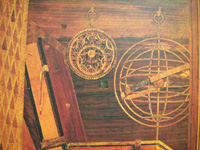 Fig. 1.4. Astrolabe and armillary sphere, Urbino studiolo.In the studioli this transformation in visuality may be characterized as a polithetic overlap rather than an abrupt departure.11 Mechanical practices such as perspective recalibrated rather than replaced earlier rhetorical traditions. Drawing extensively from the writings of Cicero, Pliny, Quintilian, and Virgil, Alberti's treatise on the subject—in 1435 the first of its kind—is not circumscribed by the mathematical demonstrations of Euclid or Ptolemy. In De pictura, Alberti is as concerned with what should be depicted in a work, its subject or historia, as with its instrumental execution. It has been noted, in fact, that Alberti's treatise served his contemporaries more as a discursive explanation of perspective than as a practical manual.12 Most quattrocento perspectives, including such architectonic, in-the-round compositions as Andrea Mantegna's Camera degli Sposi at Mantova, the Sala dei Mesi at Ferrara, and the Montefeltro studioli, did not follow Alberti's prescriptions literally but were assembled according to methods conceived in the artisan's workshop by the "coarse wisdom" of "grassa Minerva."13
Fig. 1.4. Astrolabe and armillary sphere, Urbino studiolo.In the studioli this transformation in visuality may be characterized as a polithetic overlap rather than an abrupt departure.11 Mechanical practices such as perspective recalibrated rather than replaced earlier rhetorical traditions. Drawing extensively from the writings of Cicero, Pliny, Quintilian, and Virgil, Alberti's treatise on the subject—in 1435 the first of its kind—is not circumscribed by the mathematical demonstrations of Euclid or Ptolemy. In De pictura, Alberti is as concerned with what should be depicted in a work, its subject or historia, as with its instrumental execution. It has been noted, in fact, that Alberti's treatise served his contemporaries more as a discursive explanation of perspective than as a practical manual.12 Most quattrocento perspectives, including such architectonic, in-the-round compositions as Andrea Mantegna's Camera degli Sposi at Mantova, the Sala dei Mesi at Ferrara, and the Montefeltro studioli, did not follow Alberti's prescriptions literally but were assembled according to methods conceived in the artisan's workshop by the "coarse wisdom" of "grassa Minerva."13
8
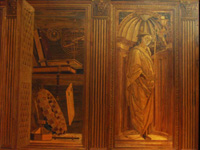 Fig. 1.5. The theological virtue of Faith, Urbino studiolo.From a post-daguerreotype point of view, one might presume that the appearance of the studioli underscored a desire for "realistic" imitation in representation. Compositional discontinuities in the studioli would be dismissed, under such a premise, as small bumps in the road toward a seamless verisimilitude. For the quattrocento mind, however, space was more heterogeneously conceived, with thought emerging precisely from within its discontinuities. Alberti's recommendation that painters imitate directly from nature also urges them to "leave more for the mind to discover than is actually apparent to the eye."14
Fig. 1.5. The theological virtue of Faith, Urbino studiolo.From a post-daguerreotype point of view, one might presume that the appearance of the studioli underscored a desire for "realistic" imitation in representation. Compositional discontinuities in the studioli would be dismissed, under such a premise, as small bumps in the road toward a seamless verisimilitude. For the quattrocento mind, however, space was more heterogeneously conceived, with thought emerging precisely from within its discontinuities. Alberti's recommendation that painters imitate directly from nature also urges them to "leave more for the mind to discover than is actually apparent to the eye."14
9The influence of artistic works and mechanical processes on habits of late quattrocento thought—from the jigsaw puzzle assembly of intarsia panels to the comprehensive planning of palaces and cities—is complex and subtle. Even those instruments that "magically" reflected or amplified the appearance of the world, including such technical innovations as the mirrors and lenses found in each studiolo, expanded on well-established metaphors for thought and memory. When considering these items from hindsight, we must not forget that they were used to different (or further) ends than we might expect.15 Along with emblems, paintings, poems, and architectural ornament, they provided the materials of thought. The gravitating concern in the studioli was not optical realism but intellectual stimulation and ethical preparation in a turbulent, often violent culture.
10Federico and his colleagues embraced the mathematical arts with a passion imbued with a deep appreciation of the spoken and written word.16 If Alberti's velo (veil) of intersected lines supplied the artisan and observer with a new proportional harness for visualizing experience, the architectonics of memory sustained accord between the senses and intellect through mathematical, literary, and visual figures. Quintessentially, the studioli are "visual panegyrics,"17 akin to and yet distinctly removed from historical precedents and antecedents.
• • •
11This investigation is structured in seven parts. In chapter 2, I describe the studioli, comparing their contents, compositions, and experiential (or phenomenological) character. In chapter 3, I propose hypotheses from these comparisons and outline methods of inquiry. In addition to the studioli, my investigation draws from the earliest surviving index of the ducal library, the Indice Vecchio (abbreviated as "I.V."), a document that offers a bibliographical sketch of intellectual commerce at Urbino during the studioli construction. Specific works in this index are referenced, as are relevant works by Federico's colleagues, including Alberti, Ficino, Nicholas of Cusa, and Bartolomeo Platina.
12What did the quattrocento think about thinking? How were its processes bound to architecture, and vice-versa? This question occupies chapter 4, in which I examine the interdependence of architecture and memory in the education of a quattrocento prince. Emphasis here is placed on the imagery in the Gubbio studiolo, which reflects an educational agenda and registers the transition of governance from Federico, who died during its construction, to his ten-year-old son, Guidobaldo. Although both studioli embody a common pedagogical foundation, the architecture of the Gubbio studiolo provided an ideal setting—a florilegium18—for cultivating the "right" habits of thought recommended in humanist learning. Distilling this point further, chapter 5 is a short stopover that considers the colors and ornament of the ceiling at Gubbio with regard to contemporary astrobiological theories.
13How would Federico have conducted a guest through the Urbino studiolo? Had he cultivated a repertoire, an idealized narrative, propagandistically conceived? Or would the duke have tailored a unique itinerary to each visitor, according to his perception of the other's vested interests, or a subtle or stern message he wished to convey? To what extent were Federico's narratives extemporized? Would he have indulged a guest to muse aloud, to ask questions to which he could then knowledgeably respond? Would he have revealed the literal and literary associations of specific images so that a visitor might better appreciate the intellectual allusions? Would he have permitted—possibly even encouraged—his astonished guests to touch the intarsia? Did the duke stoop to think, himself?
14Chapter 6 offers a close reading of the Urbino studiolo as an engine for Federico's governance. The composition, imagery, and contemporary accounts of the studiolo provide clues to its central role(s) in the duke's daily life and, more generally, reflect the complex interplay of intellectual, material, and political craft in late quattrocento Italy. We see how the Urbino studiolo provided a recombinatorium for thought and how the presence of the duke and his guests within would have provided its motivating force.
15Where fate proved to be capricious to the Montefeltro—the paternal lineage ended with Federico's son, Guidobaldo—history has been kinder, largely due to the quality of art and literature produced by members of their court and sympathetic biographies composed by contemporaries and historians. Some might argue, in fact, that history has perhaps been too kind to Federico, turning a blind eye to episodes that do not quite fit with his spotless reputation for honor and faithfulness. For example, the recent discovery of a coded letter that implicates him in the Pazzi conspiracy of 1478 suggests that the duke may have consciously sought to undermine the fragile union of the Italic peninsula that he was paid to uphold. More surprising than Federico's involvement, however, is the assumption of a one-to-one correspondence between man and myth, particularly given the context. Machiavelli's recommendation that a prince "not deviate from what is good, if possible, but be able to do evil if constrained" is a sober reflection on the political milieu of the late quattrocento, which was certainly not juste in spite of its idealized trappings.19
16To what extent were the studioli and other works of the duke's "art" mere products of humanist propaganda? Midpoint between dismissive and dumbstruck is the objective mindset to appreciate how pragmatic idealism shaped Federico's leadership and patronage. If Federico gained a reputation for faithfulness, it may have been not as the result of an unerring résumé but rather by comparison to contemporaries. Cast in a certain light, the iconographic presence of the virtues (including Faith) in the Urbino studiolo may appear overtly self-promotional and self-aggrandizing; considered within an oral culture steeped in mnemonic traditions, such images were also reminders that one's fate is determined in large part by the whims of human pettiness, fragility, and circumstances beyond one's control. Architecture and its ornament were the food and furniture for thought, not its superficial husk, and the uses of a work took place whether one stood in its presence or far afield. One must therefore scrutinize the context from which humanist panegyrics such as the studioli emerged, sorting through the honorifics and inflated rhetoric to weigh the violent circumstances that gave rise to them, as well as to tease out other views hidden between the lines.
17For a rounder appreciation of prudence (and cleverness) in the quattrocento mind, an encomium such as offered by Vespasiano da Bisticci—"all those to whom [Federico] gave his word bear witness that he never broke it . . . whether under obligation or free"20—must be balanced with such candid assessments as Machiavelli's "In What Way Princes Must Keep Faith": "One could furnish an infinite number of examples, and show how many times peace has been broken, and how many promises rendered worthless, by the faithlessness of princes, and those that have been best able to imitate the fox have succeeded best."21 From historical evidence it is clear that Federico inclined naturally to the shrewd action and policy of the fox.
18The secretive encoding of the duke's role in the Pazzi conspiracy points to the "practical" side of rhetorical and mnemonic training and reveals that alphanumeric recombination was an engine for tactical application as well as a source of meditation and divine speculation. Coded messages were integral to late quattrocento military and political strategy, and if they weren't the bread and butter of courtly entertainment, they certainly provided its spice: as Baldassare Castiglione notes at the outset of The Book of the Courtier, "under various disguises [including a 'game of emblems'] the company disclosed their thoughts figuratively to whom they liked best."22 Perhaps it is a surprise only to us, looking back across half a millennium through eyes that seek decisive meanings, attributions, and judgments, that an environment as pedagogically and ethically charged as the studioli would be so open to interpretation. This "openness" was and is the power and allure of the studioli.
19Although the original meanings and uses of the studioli will never be entirely transparent, their architecture enables us to appreciate the concerns of our Renaissance predecessors, just as the studioli had equipped Federico and his cohorts to approximate the ideals of their ancestors. This study does not presume to exhaust the studioli of their significance, an impossible folly: my objective is to investigate a particular seam in the studioli that has escaped notice.23 By examining their physical architecture, we can learn much about late quattrocento practices in architectural mnemonics. In turn, better understanding of the workings and uses of the memory reveals significances of architecture during this period that have not been fully considered. It is my hope that this research contributes to a deeper appreciation of the mnemonic exponent of chambers such as the studioli and, more generally, that it underscores the remarkable suppleness of architecture as a discipline and expression of thought.
Notes
Note 1: "By humanism we mean merely the general tendency of the age to attach the greatest importance to classical studies, and to consider classical antiquity as the common standard and model by which to guide all cultural activities." Kristeller, Renaissance Thought and Its Sources, 88. back
Note 2: The seven liberal arts consisted of the mathematical arts (the quadrivium: arithmetic, geometry, astronomy, and music) and the verbal arts (the trivium: grammar, dialectics, and rhetoric). back
Note 3: The Christian virtues include the four cardinal virtues—justice, prudence, fortitude, and temperance—adopted from the Old Testament (Book of Wisdom 8:7–8) and classical pedagogy (Cicero's De inventione). At times Magnanimity was adjunct to Temperance. The theological virtues are faith, hope, and charity. back
Note 4: There is five hundred years of speculation about Federico's true parents and his relationship to Ottaviano, whom he called "fratello." More recently, according to Olga Raggio, Federico and Ottaviano (b. 1424) were both born of Count Guidantonio da Montefeltro's daughter, Aura, and the count's distinguished military captain, Bernardino degli Ubaldini (Gubbio Studiolo, 16). Federico was thus grandson to Count Guidantonio. Upon Federico's death on 10 September 1482, Ottaviano, a noted scholar and astronomer, was appointed regent for the duchy, where he supervised the completion of various architectural projects. The services of Francesco di Giorgio were retained until 1487. See Gubbio Studiolo, 72. back
Note 5: Findlen, Possessing Nature, 112–13; Thornton, Scholar in His Study, 120–23. back
Note 6: "One of his [Federico's] cabinets was adorned in a fashion so wonderful that no one could say whether it was done with a brush, or in silver, or in relief." Vespasiano da Bisticci, Vespasian Memoirs, 101. back
Note 7: As championed by Andrea Vesalius and Sir Francis Bacon. For a discussion of the "virtual witnessing" practiced by members of the Royal Society (expanding upon the principles of Bacon), see Eamon, Science and the Secrets of Nature, 338–39: "Although Boyle originated the technology of virtual witnessing, as a literary form it came to characterize the style of the Royal Society as a whole. The technology of virtual witnessing involved 'the production in a reader's mind of such an image of an experimental scene as obviates the necessity for either its direct witness or its replication.' The 'prolixity' of descriptions of experiments and the detailed, naturalistic illustrations that went into the society's publications aimed to create the impression of verisimilitude. They were designed to convey not just the idea of an experiment but 'a vivid impression of the experimental scene.' . . . reporting their experiments the society shunned ornamental language and strove to 'represent Truth, cloth'd with Bodies, and to bring Knowledg back again to our very sense, from whence it was first deriv'd to our understandings.'" back
Note 8: Camillo, Opere, 66–67. back
Note 9: Ficino, Book of Life, 3.15.135. back
Note 10: For a discussion of concinnitas, see Alberti, Art of Building, 9.5.305, as well as Joseph Rykwert's gloss on the subject (421–22). For a discussion of the transition from perspectiva naturalis (medieval optics) toward perspectiva artificialis, see Pérez-Gómez and Pelletier, Architectural Representation and the Perspective Hinge, 16–29. back
Note 11: I do not mean to imply a categorical history of visuality but rather, as Michel Foucault and Jonathan Crary have discussed, a genealogy of practices that may be retraced (Crary, Techniques of the Observer, 6). This view of history has been described by Barbara Duden as polithetic—consisting of discontinuous yet overlapping strands, like a hemp rope (Disembodying Women, 90). back
Note 12: Elkins, Poetics of Perspective, 84–89. back
Note 13: In the first passage of De pictura, Alberti borrows a Ciceronian proverb (from De amicitia 5.16) concerning the "coarse senses of Minerva" to distinguish the sensate knowledge of a painter from a mathematician's abstract mensurations (see Kemp, "Introduction," 12). In De architectura (1.1.1), Vitruvius refers to the craftsman's clever wisdom as sollertiae. This term is found in the Prohemium of Piero della Francesca's treatise on the five "platonic" solids, De quinque corporibus regularibus, dedicated to Prince Guidobaldo: "qui non minori artis studio/ingenio/solertia/& industria fuerunt." A modern-day example of sollerzia is offered by the scuretto (little darkness), a small gap in an architectural joint that allows for the visual play of light and shadow—and the physical play of expansion and contraction—between different materials. Antoine Wilmering provides an exacting analysis of artisanal variations between the studioli (Gubbio Studiolo, vol. 2). Innovative subtleties in intarsia work appear to have increased in direct proportion to trade competition. Whether these embellishments were cultivated with the assistance of mirrors, as David Hockney has suggested (Secret Knowledge), is a speculative matter. back
Note 14: Alberti, On Painting, trans. Grayson, 2.42.77. back
Note 15: Dora Thornton has analyzed the practical uses for mirrors and lenses in the Renaissance study (Scholar in His Study, 141–42, 167–74) and, along with Luciano Cheles and others, has pointed out their iconographic correlation to prudence as a virtue of self-reflection. There are further associations. back
Note 16: Christine Smith has investigated the sources and architectonic influences of rhetoric on humanism in Architecture in the Culture of Early Humanism. This dissertation builds on her question: "How did the Humanists use what they saw around them [architecture and its ornament] to understand what they could not see, like the nature of the soul, their position in history, and their relation to the Classical past?" (xii). back
Note 17: In a fall 2000 lecture at New York University, Lina Bolzoni used this phrase in discussing the tradition of ut pictura poesis. The historical interdependence of linguistic and visual figures, articulated in Horace's Art of Poetry, thrives in Alberti's definition of istoria in De pictura and in Castiglione's self-deprecating description of the Book of the Courtier as a "picture" by a "humble painter" (from the dedicatory letter to Lord Dom Miguel de Silva, bishop of Viseu). For more on this subject, see Lee, Ut Pictura Poesis. back
Note 18: "A florilegium is basically the contents of someone's memory, set forth as a kind of study-guide for the formation of others' memories. . . . The most familiar variety brings together topics, vices and virtues and socially useful habits, such as those for study or for civic behavior." Carruthers, Book of Memory, 174. back
Note 19: Machiavelli, The Prince, chap. 18. back
Note 20: Vespasiano da Bisticci, Vespasian Memoirs, 85–86. back
Note 21: Machiavelli, The Prince, chap. 18. back
Note 22: Castiglione, Book of the Courtier, 12. back
Note 23: It is reasonable to question what one could possibly hope to discover from a topic so thoroughly investigated as the studioli. There is always something worthwhile, it seems. Pasquale Rotondi has provided a fundamental account of the architectural construction of the ducal palace at Urbino. Olga Raggio and Antoine Wilmering's publication on the Gubbio studiolo provides a valuable history of its palace and the quattrocento practice(s) of intarsia. The Metropolitan Museum's survey also includes Martin Kemp's account of perspectival methods used in the Gubbio studiolo, which should be considered alongside James Elkins's research on the heterogeneous nature of quattrocento perspectives. Numerous scholars, most recently Lorne Campbell, Cecil H. Clough, and Marcin Fabianski, Pier Luigi Bagatin, Luciano Cheles, and Virginia Grace Tenzer, have provided a wealth of iconographical data about the imagery and architectural ornament in the studioli and throughout the ducal palaces. Cheles has also included thorough commentary on the organization and character of the portraiture in each studiolo. Maria Grazia Pernis has provided significant background material on the influence of Ficino and Neoplatonism on the court of Urbino and on the professional and aesthetic competition between Federico and Sigismondo Malatesta. Pernis has also offered provocative speculations on literary narratives underlying spatial sequences in the Urbino palace. I am grateful to Martin Kemp for sharing his thoughts on these many views during continued research at the Canadian Centre for Architecture. back